If you want to examine the material in a particular Market, select a market segment using the Market button above. Select Markets to return to Markets page. Other links will take you to other destinations.
Mesh and Geo-Grids
Mesh
Basalt mesh can be use in a number of different ways. In addition, there are a number of different sizes and types of basalt mesh or geo-grid. The product can be produced from a scrim-like patterned material, to an open weave mesh material. In the finer meshes, the warp is made of bundles of resin bonded fibre, which are then twisted. The weft is untwisted resin bonded bundles. To make the mesh, the weft is inserted between the twists in the warp. Larger mesh configurations are produced using bundled fibre, to produce ribbon-like materials. The larger aperture meshes have warp and weft ribbons that are combined to produce wider ribbons. The wider ribbon configurations are then stitched into the mesh type weave.
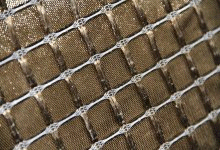 |
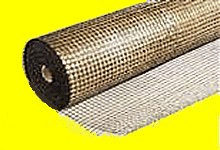 |
Meshes and geo-grid are available in different formats. In addition, StoneRod basalt veil and StoneRod uni-directional fabrics are available, which can be used to provide externally applied concrete or other structural material reinforcement.
| Mesh sizes are: |
| 5 mm x 5 mm |
| 10 mm x 10 mm |
| 25 mm x 25 mm |
| 50 mm x 50 mm |
| 100 mm x 100 mm |
In addition, on special order, other sizes can be manufactured. Obviously, production requirements need to be met and special materials may require some experimentation. Other formats and sizes are not off the shelf items.
Geo-Grids
In addition to the StoneRod mesh materials, Geo-grid products are also available. There are two formats of grid, being Asphaltic geo-grid and rebar geo-grid. The asphaltic geo-grid is formed by impregnating woven basalt fibre scrim with asphalt and then drying. The asphaltic geo-grid is available in rolls having a 25 mm x 25 mm grid aperture and lengths of 50 metres to 200 metres. The rolls are 1 metre to 4 metres in width.
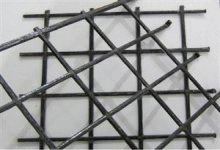 |
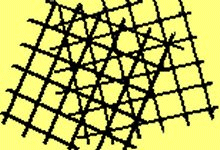 |
Qualities of asphaltic geo-grid are :
High tensile strength, ultraviolet resistance, stable chemical resistance and ageing resistance.
High temperature and frost resistance. Application temperatures of between -260 and +650 degrees Celsius are acceptable.
Elongation at break, or fracture, is approximately 3.4%.
The material is stable with good thermal stability and long-term creep resistance.
High tensile strength and low elongation, or deformation qualities.
Good physical and chemical stability. High chemical resistance to alkalis and acids.
Strong resistance to biological erosion and climatic changes.
In asphaltic concrete roads, reinforced asphalt can be milled and planed, without damaging equipment. The mesh will not pluck as other reinforcement products do. Tests indicate that 20% thinner asphalt layers may be used.
For more information on asphalt reinforcement, read the Section on Asphalt in this site. If test program reports are of interest, copies of documentation are available on the web. A wide range of subjects are available.
Rebar Geo-Grid
Rebar type Geo-grid is not a StoneRod trademark registered product. The material is a patented Geo-grid produced by GBF. GBF Basalt Geo-grid is produced using 4 mm fibre rebar, manufactured by GBF, under patent. The rebar has high strength and chemical resistance, making its performance desirable in special high-quality and performance demanding projects. Geo-grid can be made having apertures of 25 mm x 25 mm, or 50 mm x 50 mm. The intersections are fixed using special resin impregnated basalt roving. Due to its rebar construction, it cannot be rolled. Therefore, it is packed piece by piece, with a maximum dimension of 2 metres.
Counter tops
StoneRod basalt mesh can improve the toughness of concrete working tops. Polished or imprinted concrete surfaces can be produced using mesh reinforcement. It is no longer necessary to produce thick concrete tops to provide the necessary cover to reinforcement. The concrete can now be made in thin-skinned products using strong fibre mesh reinforcement. Steel reinforcement or wire needs a minimum of 25 mm cover to withstand the inevitable ingress of carbon dioxide which lowers the resistance to rusting of steel in concrete. This ingress does not affect StoneRod fibre meshes which can be placed close to surfaces.
Concrete tops can be free formed, using moulds constructed to suit. The bottom of the mould should be flat and true, when concrete will be polished, or fitted with an imprinting plastic or rubber mould. If imprinting is to look like aged wood, or quarried stone, the concrete should be mixed with a suitable pigment. Use a suitable mould release compound.
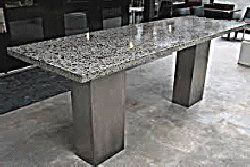 |
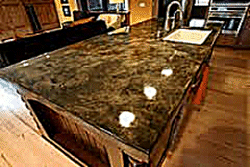 |
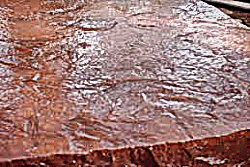 |
For polished finished, with exposed aggregate, small aggregate will be mixed in the concrete. For variegated finishes, coloured gravels could be blended and laid over the bottom of the mould. The mould then is half filled with fluid mortar, mixed using a good quality water reducing admixture. The use of an admixture will give good fluidity without the addition of excessive water. Lay the pre-cut fibre mesh over the wet mix, and press in gently to get mortar through the apertures. Concrete should be vibrated well to remove entrapped air. Fill the mould to the top, screed off and wrap the whole unit in cling-wrap plastic film.
Allow the concrete to lie quietly, in a cool area, for a period of at least 21 days. This patience will be rewarded with a high-strength quality top. Some tips: Don't forget to make the mould flare slightly towards the top, to aid in demoulding. And use a suitable release compound, which should be lightly spread over the whole surface of the mould, to assist in demoulding the top, without damage. Don't use too much release agent, as it will hold back bubbles, during vibration, which will mar your finish. Finally, contact HTC for a suitable grinding machine and abrasive pads.
Structural repairs
The use of mesh in conjunction with epoxy or other adhesives is becoming more and more acceptable to the construction industry. in addition to imparting design strength in some construction methods, mesh can be used to strengthen cast products. More information is given in the Thin-skin Section, of this website.
Mesh applications can be used in conjunction with gunite to restore profiles to eroded or corroded structures. Many concrete piers, under jetties, become corroded in the splash zone. To rehabilitate, it is necessary to remove all contaminated concrete. The eroded areas are broken back to clean concrete, high pressure water blast cleaned and then re-profiled to correct lines. Into the wet gunite push in basalt mesh to provide for any reinforcement loss and then apply an extra coat of gunite. For extra protection a suitable anti-corrosive coating could be applied.
Metal piles can be protected by high-pressure water blast to clean steel. Apply a layer of moisture tolerant epoxy adhesive and wrap the pile in mesh, ensuring that all folds and blemishes are stretched out. Apply a further layer of epoxy over the bonded mesh.
 |
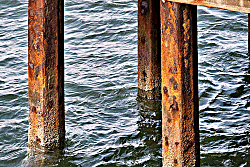 |
Unstable brickwork and masonry can be strengthened and stabilised by trowelling on a layer of mortar. Embed StoneRod mesh into the wet mortar and encapsulate the mesh with a further layer of mortar. With all cementitious products, good curing is essential. Typical sulphate contamination of concrete causes random cracking patterns. If concrete is not repaired, the reinforcing will start to corrode and the concrete will spall off the surface.
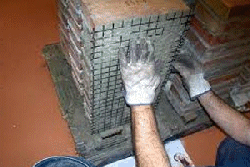 |
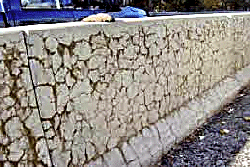 |
Sewage plant repair
Sulphate damage is common in sewage treatment works. The sulphates in the sewage attacks the cement paste in thickening tanks, canals, aeration tanks, digesters, pumping stations, etc.
Sulphate damages structures can be refurbished by removing damaged concrete, retro-fitting damaged rebar using basalt rebar, applying a levelling layer of gunite, embedding Stonerod basalt fibre mesh and embedding in a finishing layer of gunite. The surfaces can be screeded to levels and trowelled to an acceptable finish. Always cure concrete and gunite correctly.
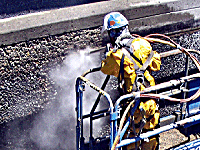 |
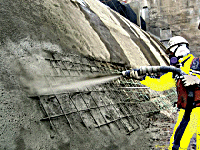 |
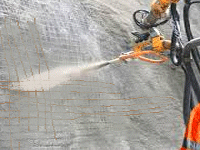 |
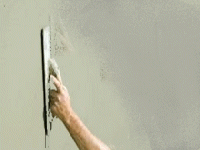 |
There are many other uses for StoneRod mesh. If you have a special need, or require advice, do not hesitate to email us.
 |
We pride ourselves on our professional service, market knowledge, quality, and most competitive prices.
Return to Top of Page.